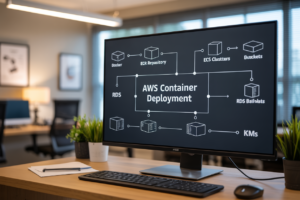Ever tried explaining to your boss why Snowflake costs so much when “it’s just a database in the cloud”? If you’ve found yourself fumbling through that conversation, you’re not alone.
The truth is, Snowflake’s architecture is a masterpiece of engineering that most people—even experienced data professionals—don’t fully understand.
In this guide, we’ll break down Snowflake’s architecture into digestible components that actually make sense. You’ll learn exactly how the separation of storage, compute, and services layers creates that magic combination of performance and flexibility that’s worth every penny.
But here’s what nobody tells you about Snowflake’s architecture: understanding it properly can completely transform how you approach your company’s entire data strategy…
Snowflake’s Multi-Cluster Architecture Explained
Cloud-agnostic platform benefits
Snowflake’s genius lies in its platform-agnostic approach. Running on AWS, Azure, or Google Cloud without missing a beat? That’s flexibility you can’t ignore. Companies avoid vendor lock-in while leveraging each cloud’s unique strengths—a game-changer for businesses with complex multi-cloud strategies.
Separation of storage and compute
Storage Layer: Where Your Data Lives
A. Columnar storage format advantages
Snowflake’s columnar storage crushes traditional row-based formats when analyzing large datasets. You’ll see blazing-fast query performance since it only reads relevant columns rather than entire rows. This approach drastically reduces I/O operations, saves storage space through better compression, and optimizes analytical workloads that typically focus on specific data attributes.
Compute Layer: Processing Power on Demand
Virtual warehouses and resource isolation
Snowflake’s compute layer is where the magic happens. Virtual warehouses are dedicated compute clusters that process your queries without stepping on each other’s toes. Need to run analytics while loading data? No problem. Each warehouse works independently, so your CEO’s dashboard won’t slow down when IT runs that massive data migration.
Auto-scaling and auto-suspension features
Why pay for compute power you’re not using? Snowflake’s warehouses automatically suspend after a period of inactivity, saving you cash while you sleep. And when workloads spike, auto-scaling kicks in to add more servers without you lifting a finger. It’s like having an IT team that never takes vacation.
Workload management across multiple warehouses
Got different departments with unique needs? Marketing needs speedy dashboards while data science runs complex models. Snowflake lets you create separate warehouses for each team, preventing resource hogging. It’s like giving everyone their own sandbox rather than forcing them to share the same tiny playground.
Cost optimization through right-sizing
Size matters with virtual warehouses. Too small? Queries take forever. Too large? You’re burning money. Snowflake’s sizing options (XS through 6XL) let you match compute power to actual needs. Start small, monitor performance, and adjust. Your finance team will thank you when the bill arrives.
Cloud Services Layer: The Orchestration Engine
Cloud Services Layer: The Orchestration Engine
Think of this layer as Snowflake’s brain. It handles everything from who can access what data to figuring out the fastest way to run your queries. The beauty? It manages all the complex infrastructure stuff behind the scenes while you focus on your data. No more late nights patching servers or worrying about security updates.
Key Architectural Advantages for Business
Near-infinite scalability for growing data needs
Snowflake’s architecture doesn’t force you to choose between scaling up or out. Need more storage? Done. Sudden spike in query demands? No problem. The platform automatically expands resources when you need them and shrinks when you don’t. No hardware planning meetings or capacity headaches ever again.
Pay-only-for-what-you-use pricing model
Traditional data warehouses force you into expensive fixed-capacity contracts. Snowflake flips this model on its head. Computing resources are measured in per-second increments while storage costs stay separate. Your finance team will love the predictability, and you’ll love not paying for idle resources during quiet periods.
Cross-cloud and cross-region data sharing
Snowflake breaks down data silos without copying or moving anything. Share live, ready-to-query data across your organization, with partners, or even customers—regardless of which cloud provider or region they use. This eliminates complex ETL processes and ensures everyone works with a single source of truth.
Built-in security and governance features
Security isn’t bolted on as an afterthought with Snowflake. End-to-end encryption, role-based access controls, and automatic compliance with major regulations come standard. The platform handles sensitive data protection while providing the visibility your security team demands—all without performance trade-offs.
Zero maintenance operations
Remember those weekend maintenance windows? They’re history. Snowflake handles all patching, upgrades, and optimizations behind the scenes. No indexes to manage, no vacuuming databases, no tuning required. Your team can finally focus on extracting value from data instead of babysitting infrastructure.
Snowflake’s three-layer architecture represents a fundamental shift in how modern data platforms operate. The separation of storage, compute, and cloud services layers creates a flexible, scalable system that adapts to your business needs. This design eliminates traditional data warehousing challenges like resource contention, scaling limitations, and complex management overhead.
As organizations continue to face growing data volumes and increasingly complex analytics requirements, Snowflake’s architecture provides a compelling solution. Whether you’re dealing with massive datasets, unpredictable workloads, or need to maintain strict performance SLAs, Snowflake’s design principles deliver the agility modern businesses demand. Consider how these architectural advantages could transform your data strategy and unlock new possibilities for your organization.




















